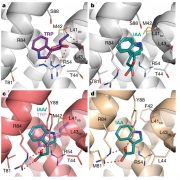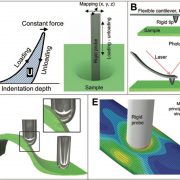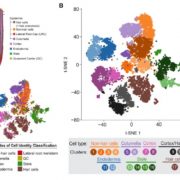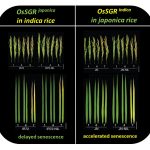A FRET sensor reports kinase activity in planta (eLIFE)
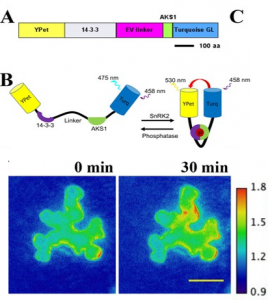 Abscisic acid (ABA) is a phytohormone involved in imparting tolerance to a variety of stress conditions. Importantly, ABA is involved in stomatal closure, mediated by the sucrose non-fermenting1-related protein kinase 2 (SnRK2) family of proteins. To report SnRK2 activity in vivo, Zhang and co-workers developed a FRET-based fluorescent sensor (named SNACs for SnRK2 activity sensor). This sensor exploits a domain from a natural substrate of SnRK2s and a 14-3-3 domain protein that responds to phosphorylation of the substrate protein. When SnRK2 phosphorylates the substrate protein, conformation of the sensor changes to induce a Förster resonance energy transfer (FRET) between the fluorophores, resulting in fluorescence emission. The sensor reported SnRK2 activation by ABA, but high ambient CO2 and external MeJA application failed to induce SnRK2 kinase activity, suggesting that stomatal CO2 signaling requires basal ABA and SnRK2 signaling, but not SnRK2 activation. This report is expected to fuel development of sensors for other phosphorylation-based processes and studies to determine the pathway(s) involved in CO2 and MeJA-induced stomatal closure. (Summary by Pavithran Narayanan @pavi_narayanan) eLIFE 10.7554/eLife.56351
Abscisic acid (ABA) is a phytohormone involved in imparting tolerance to a variety of stress conditions. Importantly, ABA is involved in stomatal closure, mediated by the sucrose non-fermenting1-related protein kinase 2 (SnRK2) family of proteins. To report SnRK2 activity in vivo, Zhang and co-workers developed a FRET-based fluorescent sensor (named SNACs for SnRK2 activity sensor). This sensor exploits a domain from a natural substrate of SnRK2s and a 14-3-3 domain protein that responds to phosphorylation of the substrate protein. When SnRK2 phosphorylates the substrate protein, conformation of the sensor changes to induce a Förster resonance energy transfer (FRET) between the fluorophores, resulting in fluorescence emission. The sensor reported SnRK2 activation by ABA, but high ambient CO2 and external MeJA application failed to induce SnRK2 kinase activity, suggesting that stomatal CO2 signaling requires basal ABA and SnRK2 signaling, but not SnRK2 activation. This report is expected to fuel development of sensors for other phosphorylation-based processes and studies to determine the pathway(s) involved in CO2 and MeJA-induced stomatal closure. (Summary by Pavithran Narayanan @pavi_narayanan) eLIFE 10.7554/eLife.56351



